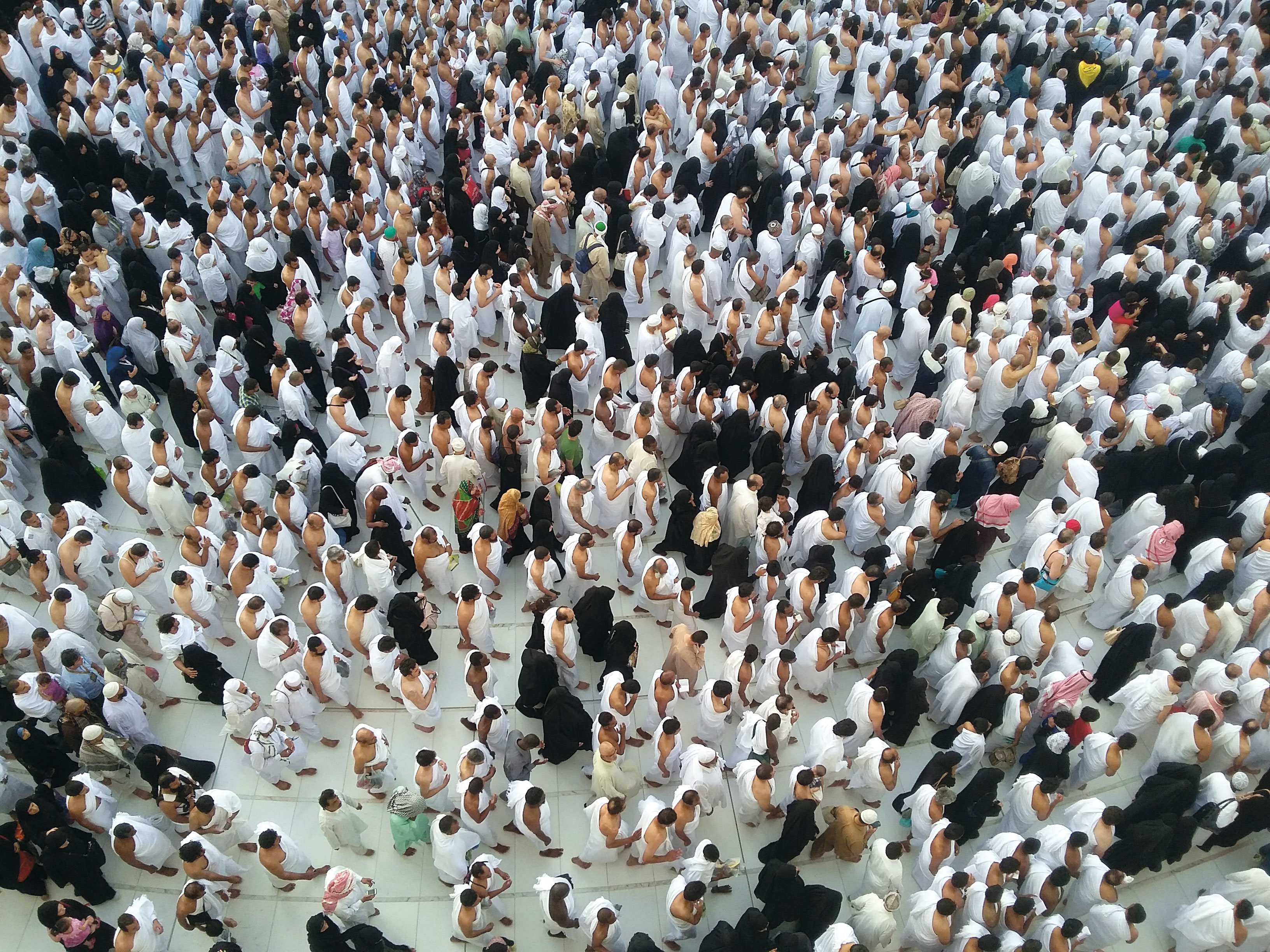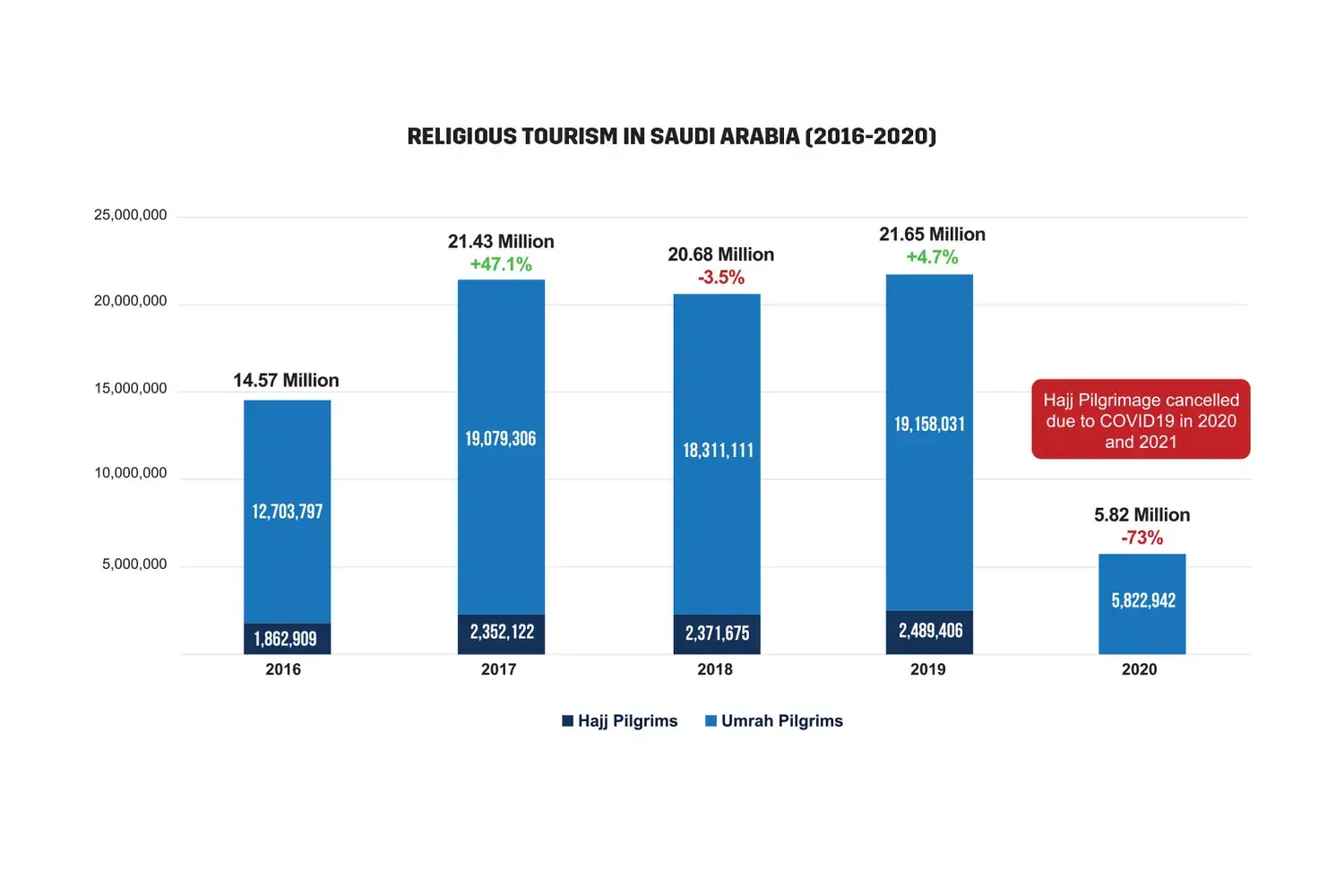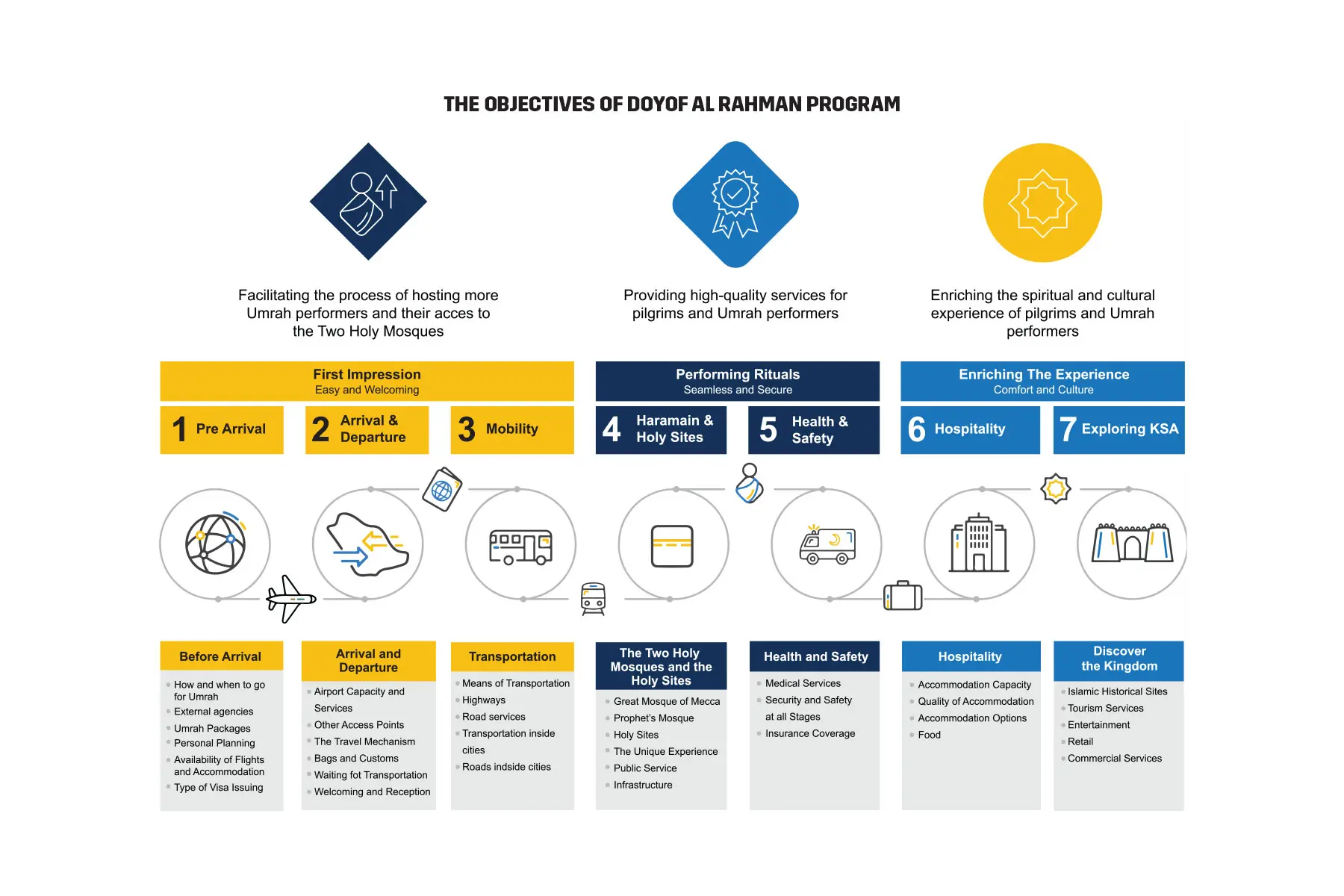Religious Tourism in Saudi Makes Mecca the 13th Most Visited City in 2019
02 June 2022•
Hajj and Umrah are religious pilgrimages performed by Muslims from all over the world. Mecca and Medina are considered to be the holiest sites in the world for more than 2 billion Muslims living today. Hajj is an annual six-day pilgrimage to Mecca made by over 2 million Muslims each year; Islam requires every financially and physically able Muslim to make the journey once in their lifetime. Umrah is a shorter pilgrimage to Mecca that can be performed at any time of year; over 19.1 million pilgrims completed Hajj in 2019.
Hajj and Umrah pilgrimages have taken place over centuries, with the first Umrah pilgrimage recorded to have taken place in 629 CE. Islamic scholars have said that the first Hajj was led by Prophet Muhammad himself in 632 CE, the year of his death; may peace be upon him. Saudi Arabia are the custodians to the two Holy Mosques and Holy sites, and have invited Muslims from over 186 countries each year to perform their religious duties. Hajj is the world’s largest single annual human gathering today, with nearly 2.5 million pilgrims descending on Mecca together at once, over a 1 week period each year. Prior to 1946, around 60,000 pilgrims visited Mecca annually; that’s a 500X expansion in annual pilgrims to be witnessed in 84 years should Vision 2030’s target of 30 million pilgrims per year be realized.
The Ministry of Hajj and Umrah are responsible for all pilgrim related activities and coordinate with over 30 government entities to support the sector. Over 350,000 employed by the sector, had to cancel the Hajj pilgrimages for non-domestic Muslims in both 2020 and 2021 due to the health and safety concerns surrounding the Covid19 Pandemic. This has been both a grave disappointment for Muslims worldwide, and has also had significant economic repercussions on the Saudi economy. Religious tourism contributed the vast majority of the 3% tourism contribution to Saudi’s GDP in 2016. The pandemic has reminded the Kingdom that diversification of not only its’ economy as a whole, but also its tourism sector is vital for long term sustainability; the pandemic has also highlighted the importance of developing its domestic tourism infrastructure and opportunities.




 In 2019, the Doyof Al Rahman Vision Realization Program (DARP) was launched under the umbrella of the Vision 2030, in order to create a seamless and memorable pilgrim experience program, from airport arrival, to customs, to hotel stay and transport and logistics throughout. The goal of the program is to upgrade and deliver a distinguished spiritual experience for all pilgrims coming to the Kingdom, removing any unnecessary hassle so pilgrims can focus on their personal spiritual journeys.
In 2019, the Doyof Al Rahman Vision Realization Program (DARP) was launched under the umbrella of the Vision 2030, in order to create a seamless and memorable pilgrim experience program, from airport arrival, to customs, to hotel stay and transport and logistics throughout. The goal of the program is to upgrade and deliver a distinguished spiritual experience for all pilgrims coming to the Kingdom, removing any unnecessary hassle so pilgrims can focus on their personal spiritual journeys.
This includes facilitating an e-visa process before arrival, a seamless arrival into the Kingdom with adequate transportation and logistics to both accommodation and the pilgrim’s journey to and from the Two Holy Mosques and holy sites. The Pilgrim’s Journey mapped out in the DARP program also includes initiatives to ensure rituals are performed safely, access to comprehensive health coverage, and ability to extend stays to discover Saudi Arabia’s cultural and heritage sites.
DARP has already made strides in implementing several key initiatives that have supported a better pilgrimage experience in the Kingdom, such as, but not exclusive to:
- Implementing an e-Visa process, which has reduced visa processing times from 14 days to 5 minutes
- Minimizing Saudi Immigration wait times; Pilgrims spend an average of 15min at Saudi Immigration counters as part of the Makkah Road Initiative which helps to streamline Pilgrim immigration processes
- Launched a comprehensive health insurance for pilgrims to cover health, travel and accidents related issues
- Protecting and investing in the restoration and development of 40 Islamic holy sites and mosques across the Kingdom
- In March 2022, the Ministry of Hajj and Umrah hosted a two-day conference devoted to the development of Hajj and Umrah services, titled “Transformation Toward Innovation”, aimed at exploring opportunities to enhance services provided to pilgrims
It is the intention of the Ministry of Hajj and Umrah to implement technological advancements wherever it may help to facilitate a better pilgrimage experience, or enhance health, safety, and security. In line with this, there have been several pilot projects, testing the efficacy in distributing digital wristbands and contactless access cards to Pilgrims which securely store digital identity information, necessary permits, visa and health information and immigration documentation. Some of the piloted technologies have also included digital contactless payments functionalities to facilitate easier payments and access through-out the pilgrimage, as well as geotagging for traffic monitoring and safety. In interviews conducted, it was said that contactless ID cards had higher success rates in many of the pilot programs, as many pilgrims had taken-off and lost or accidentally exchanged their wristbands with someone else when washing before prayer. The aspiration in the future is that every pilgrim will get a RFID wristband or contactless card which helps keep all of these important documents and information securely with the Pilgrim, while also providing easy payment and access to the Pilgrim’s various transportation and accommodation. It is a technologically advanced vision of how an integrated visitor experience could be in the Kingdom.
Other programs that have been piloted include the “Pilgrimage without a Bag” Program. This program assists in transporting pilgrims’ bags to their accommodation so that it is waiting for them when they arrive. Improvements in food services have also been rolled-out, expanding the provision of ready-made meals at holy-sites. The Ministry of Hajj and Umrah have also invited young Saudis to volunteer to be assistants, encouraging volunteers to help pilgrims in need of support. Another Crowd Management Program built six transmitting stations and installed 350 sensors placed throughout Mina and at Jamrat Bridge. This network will gather and analyze data about overcrowding and movement of pilgrims. Crowds and movement will also be monitored on high-definition cameras. The collected data is analyzed at a dedicated crowd-monitoring center.
In line with another Saudi Vision 2030 target of becoming a 70% cashless economy by 2030, the Saudi Central Bank (SAMA) along with the Ministry of Commerce ran a POS-system implementation drive across the country, including Mecca and Medina – a region where POS penetration has historically been amongst the lowest in the Kingdom. A POS Machine Implementation Enforcement Program was rolled-out in 2019 and was finished in 2021. The implementation of POS systems is meant to both facilitate easier payment transactions for pilgrims and tourists visiting the region, while also cracking down on money laundering and tax evasion by small merchant businesses, after implementing VAT in 2018. Hajj Bank Cards have also been issued by several local banks, allowing pilgrims to deposit money onto them when they arrive into the kingdom, so they don’t have to carry around cash with them.
In 2018, it was announced that King Abdullaziz International Airport (KAIA), Saudi Arabia’s largest airport in terms of passenger traffic, would begin looking at expansion works for a new $7.5 billion USD passenger terminal, dedicated to Hajj and Umrah pilgrims. KAIA handled 31.15 million passengers in 2016, some 3.5% more than in 2015. The masterplan envisages increasing capacity up to 42 million passengers a year by 2025, and 80 million passengers annually by 2035. The new Hajj terminal will be able to process over 7,000 arriving and departing passengers an hour, and will be able to accommodate 80,000 passengers at any one time. The new wing would also cater to the specialist dietary and religious needs of the travelling pilgrims. The KAIA construction project was temporarily put on hold during the pandemic.
A new international Airport in Taif has been under construction since 2019. The current Taif Airport, with the capacity to handle just over half a million passengers each year, is 30km East of Taif city and 70km from Mecca; though classified as a small regional airport, it does handle a few international flights as well. The new airport to be constructed 120km from Mecca will have a 6 million passenger capacity when finished, and is expected to help relieve the pressures on KAIA to cater to all 30 million pilgrims expected to travel to Mecca annually, by 2030. Taif is also an increasingly popular summer resort destination in the Kingdom.

%2Fuploads%2Fsaudi-tourism%2Fsaudi-tourism-cover.jpg&w=3840&q=75)